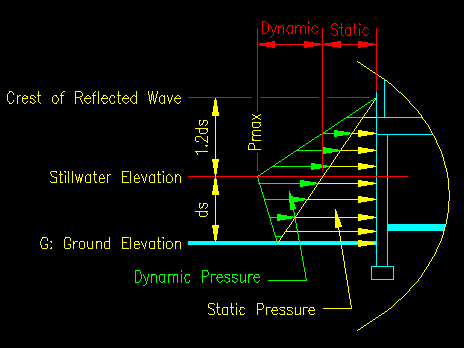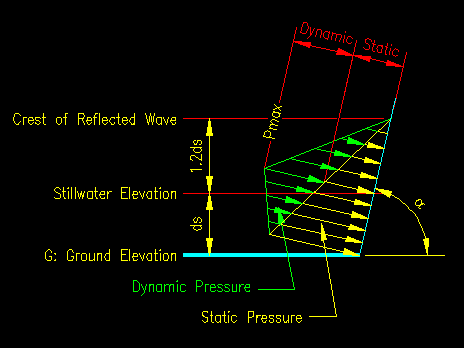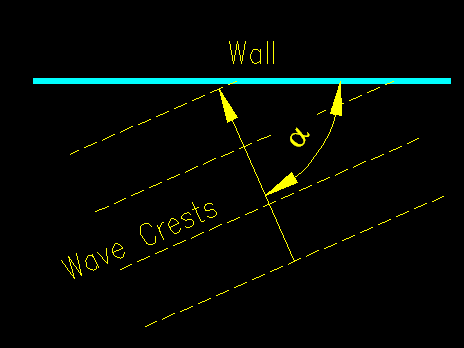| Overview |
| Definitions |
| Hydrostatic Loads |
| Hydrodynamic Loads |
| Breaking Wave Loads |
| Impact Loads |
| Example Problems |
|
References |
| Report Errors or Make Suggestions |
Section 6.5
Breaking Wave Loads
Last Revised: 11/04/2014
Breaking waves exert substantial loads on structures. ASCE 7-05 5.4.4 requires that the effects of breaking waves be considered for both their effects on vertical systems and their effects on the underside of horizontal systems due to shoaling effects.
The standard allows for the use of given equations, advanced analytical means, and experimental methods for determining the effects of wave loadings on a given structure.
ASCE 7-05 and the CCM both provide two different procedures. One for breaking waves on piles and the other for breaking waves on walls.
To compute the loads, you need to know how high the breaking wave is. This is computed with ASCE 7-05 equation 5-2:
Hb = .78ds
The equations used for computing the forces due to breaking waves are similar to the fluid dynamics equation used for computing hydrodynamic loads. There is some difference in coefficients and drag coefficients.
Breaking Waves on Vertical Pilings and Columns
The equation for computing the net force on a pile or column due to action of a breaking wave is given as ASCE 7-05 equation 5-4. Note that the recommended drag coefficients are a bit higher for breaking waves than they are for flowing water.
The load is applied as a point load at the stillwater elevation.
Breaking Waves on Vertical Walls
ASCE 7-05 section 5.4.4.2 provides two equations to be used for computing the forces on a vertical wall due to the action of a breaking wave.
The first equation gives the maximum pressure to be applied at the still water elevation. This equation combines both the hydrostatic pressure at the stillwater elevation and the dynamic pressure. Figure 6.5.1 illustrates the application of this pressure to the outside of a wall. ASCE 7-05 Figure 5-1 and CCM Figure 11-7 are similar.
Figure 6.5.1
External Pressures on a Vertical Wall
Due to Breaking Waves

ASCE 7-05 equation 5-5 computes the pressure, Pmax, at the stillwater elevation. The crest of the reflected wave is locate a distance 1.2ds above the still water elevation. The total pressure has a hydrostatic component that increases linearly with depth, so at the stillwater elevation the static component equals (1.2 gw ds). The dynamic component of the pressure at the stillwater elevation is given to be (Cp gw ds), where Cp is a dynamic pressure coefficient that depends on the building category (see ASCE 7-05 Table 1-1) and is found in ASCE 7-05 Table 5-1.
At the crest of the reflected wave the pressures are zero. At the ground elevation they equal the static pressure, (2.2 gw ds).
The force per foot of wall length is the area of the pressure diagram. ASCE 7-05 5-6 equation computes this area. The resultant force acts through the center of the area of the pressure diagram. The CCM places this force (0.1 ds) below the stillwater elevation in lieu of doing the centroid computation.
If the system has been designed to allow water behind the wall, this pressure is counter acted by a hydrostatic pressure acting from the inside. The water elevation is taken to be the stillwater elevation. The net pressure on the wall is shown in ASCE 7-05 Figure 5-2 and the change in change in net force on the wall is the result of ASCE 7-05 equation 5-6 less the area of the internal pressure distribution. The resulting equation is given as ASCE 7-05 equation 5-7.
Breaking Waves on Nonvertical Walls
If a wall is sloped, the angle of that slope can be measured from a horizontal plane. In ASCE 7-05 this angle from the horizontal is taken as a. A vertical wall has an a of 90 degrees. Given that the pressure results from fluid, the computed pressures are normal to the wall surface. Figure 6.5.2 shows the pressure distribution on the sloped wall. The resultant forces were computed in the above section and are given as ASCE 7-05 equations 5-6 and 5.7. The lateral force component can be computed using ASCE 7-05 equation 5-8 which comes from solving for the horizontal component of a force.
Figure 6.5.2
Wave Pressure on a Nonvertical Wall

Oblique Breaking Waves
If walls approach a wall obliquely, then we are interested in finding the component of the load that is normal to the wall. Figure 6.5.3 shows a plan view of this situation.
Figure 6.5.3
Waves Oblique to Wall

The component of the force normal to the wall surface is given by ASCE 7-05 equation 5-9 or by resolution of the wave force into it's components normal and parallel to the wall.